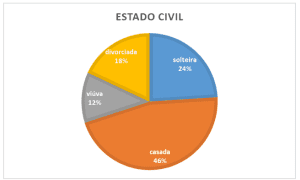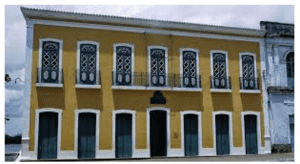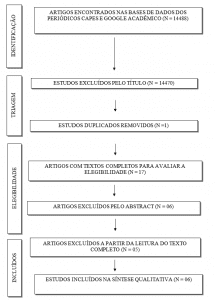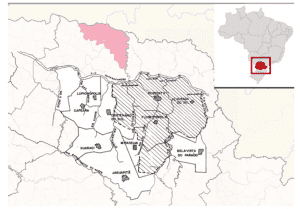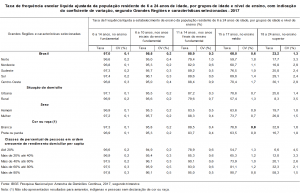ORIGINAL ARTICLE
PEDROSO, Nilda Da Conceição [1]
PEDROSO, Nilda Da Conceição. The reason for the state. Revista Científica Multidisciplinar Núcleo do Conhecimento. Year 05, Ed. 10, Vol. 15, p. 18-33. October 2020. ISSN: 2448-0959, Access link: https://www.nucleodoconhecimento.com.br/history/the-reason, DOI: 10.32749/nucleodoconhecimento.com.br/history/the-reason
ABSTRACT
With this work we intend to study the Folders of the historical collection of the national archive. They contain the Captainular Acts of the Meetings of the National Assumption Lobby in the period 1805 and 1806. Our intention is to demonstrate, through these demands, and to expose an incipient and colonized Assumption, but hardworking, politicized and developing. Demonstrate the same, the activity of a state apparatus that in the past played an important role together with the people: the Cabildo. On the other hand we intend to contribute to clarify points of questions taken to centuries and that with this monographic work are all of the past and brought to the historical present.
Key words: Folders, Chapter minutes, Lobbying, Assumption.
1. INTRODUCTION
To the team of students of the ONE Master’s Course, it was given to present a work, that of doing a study of the Chapter Acts contained in a folder corresponding to the period of a full decade: from 1801 to 1811.
These are the years that anticipated the most important event for the Republic of Paraguay: its Independence.From these years it was up to us to do the study of the years 1805 and 1806.
2. THE ASSUMPTION LOBBY – HISTORY
The institution called Cabildo had its background in a still medieval Spain. During the early Middle Ages they had their rise in the Christian kingdoms. Thus, in Castile and León they were Councils; in Aragon and Navarre: Cabildos, but in Catalonia they were called Consells. They had preponderance for the money granted to them by kings since the late 10th century. Over time, they gained autonomy and strength in government, exercising administrative and justice functions. After more than three centuries of frank activity with the people, the Cabildos in Spain were losing their strength as they strengthened the real power. But, being transplanted into America, it arises in most cities full of vigour.
In the cities of Spanish America, in colonial times, the Cabildo represented the administrative and judicial body of the municipality. Asunción, founded in 1537 by Domingo Martínez de Irala and Juan de Salazar y Espinoza, had his Cabildo created on September 16, 1541, by Martínez de Irala himself. “Being Asunción the only base of operations of the conquering company, it was needed to create a legal and administrative institution that would grant city status to the fort.” (PARAGUAYAN ACADEMY OF HISTORY, 2010, p. 165).
El Cabildo fue en el Paraguay una creación espontánea de los conquistadores sobre el modelo de los municipios castellanos. Aunque muchos fueron designados en España regidores de las tierras que debía conquistar el Adelantado Don Pedro de Mendoza, a éste no se le autorizó a fundar Cabildos, seguramente por el temor de que éstos quisieran renovar en el Río de La Plata las luchas de las comunidades terminadas en Villalar. (…) Pero el 16 de setiembre de 1541 Irala, en consorcio con los oficiales reales fundaron el Cabildo de Asunción, integrado por cinco regidores, para que entiendan en todas las cosas concernientes a la buena gobernación de esta ciudad. Bien pronto el Cabildo se convirtió en órgano importante de gobierno. No sólo cumplía las obligaciones municipales y de justicia que le eran propias, sino que ejerció variadas funciones políticas. En ocasiones llegó a asumir el gobierno total de la Provincia como lo hizo en 1676 a raíz de la destitución del gobernador Rexe de Corvalán. Durante la Revolución de los Comuneros fue protagonista principal de los acontecimientos y baluarte de la causa popular. (CARDOZO, 2015, p. 66).
The Assumption thing wasn’t the only Cabildo created. Thus, every city founded was created a Cabildo. In this way, and from Asunción, Cabildos were created in Ciudad Real de Guairá, Villa Rica, Santa Cruz de la Sierra, Santa Fe, Buenos Aires, Concepción de Bermejo, Ciudad de Veras de los Corrientes, Santiago de Jerez.
In the Act of Foundation of the Cabildo de Asunción collected by Mr. Juan Francisco Aguirre in his book “Diario del Capitán de Fragata”, it is as follows:
Haya e residan en dicho pueblo cinco regidores los cuales se junten en Cabildo con la Justicia en los días que por ellos fuese acordado para que entiendan en todas las cosas concernientes a la buena gobernación de esta ciudad de la Asunción, los cuales hagan y puedan hacer las ordenanzas municipales que cerca de las cosas susodichas les pareciese ser más convenientes […]. (AGUIRRE, 1949, n.p.).
The Cabildo had among its main functions those of issuing ordinances with force and vigour of law as well as establishing penalties for transgressors. They also soon agreed on the procedure for elections that should be made clean and healthy.
One of the first measures taken was the issuance of coins. As there was neither gold nor silver throughout the Province, they agreed to set the following values:
“A mesh hook s 1 m[antigua moneda española]aravedi ; a rescue hook s 5 maravedíes; a scoop of 16 maravedíes; a wedge s 50 maravedíes; an anvil wedge 100 maravedíes” (QUEVEDO; DURAN; DUARTE, 2001, p. 33).
These securities were later applied for the sale of the country’s products to foreign trade.Thus, the management of the Cabildo de Asunción paid off, as it showed that the province could be maintained and developed without the circulation of sealed coins.
In the Cabildo the city prison worked and in front, in the Plaza, was the scroll (that’s what it was called because it had that format), where the criminals were whipped. The Mayors were like Judges of 1st Instance of the city. The Cabildo de Asunción since its founding exerted remarkable and sustained influence on the formation of the nationality of the Paraguayan people and in the common struggles.
2.1 HISTORICAL CONTEXT
The first decade of the nineteenth century represented for Paraguay years of political-social demonstrations that stirred the stage of the Spanish-Iberian colony. The nineteenth century inaugurates in Spain, the Motherland, great transformations that will extend to its colonies: the House of Bourbon now reigned.
The Habsburg dynasty had left no successor. Political pressures imposed preference on the grandson of the French absolutist King, Louis XIV, who belonged to the Bourbon family. After a long dispute – the war of succession – in which European countries tried to prevent what had happened between Portugal and Spain from happening: the Iberian Union (1580 – 1640), where a single family took over two thrones, after the death of King Sebastian.
Finally, the French prince was accepted, who to represent the Hispanic monarchy was named Philip II. Spain goes on to adopt the French system in its political, economic, social and cultural life. Everything was copied in the Spanish Metropolis: fashion, furniture, architecture, French gardens. He centralized power in the Metropolis and distributes it throughout the colonies. The big political decisions were made personally by the monarch, advised by his ministers. While the Habsburgs focused their administration on their colonial enterprises, the Bourbons focused on people, creating the “overseas provinces.” Despite the effort, the House of Bourbon failed to preserve its colonies. American emancipation was coming in the direction that events were taking: from the Independence of North America in 1776 where from the thirteen English colonies was released quite material collected from the representatives of the Enlightenment and also a few years later (1789) from the leaders of the French Revolution, they ended up breaking the foundations of the ancient Spanish absolutist system in Hispanic-America.
External events that influenced the ideas of emancipation were added to the heavy burdens of taxes and raw materials that the colony endured after three hundred years of Spanish domination. Among them the double English invasion on the Río de la Plata (1806 and 1807) and Carlotism. There is a, in the meantime, that seemed to be the impetus for the “domino effect” in Latin America; Bonaparte’s invasion of the Iberian Peninsula. This forced the Portuguese imperial family and its entire court to flee to the Brazilian colony (1808). The presence of the dominant element on dominated soil seemed to warm native Americans’ moods of independence. After two victories in a row by the colony’s military forces ultimately expelling the English from the Río de la Plata, many Paraguayans who acted in the defense realized their ability to fight for independence. That certainty was the “gunpowder scratch” that prompted Latin America to be free of Spanish shackles.
The Cabildo represented Spanish power in America. But, by representing the people well, it became a weapon against Spanish claims, so the Cabildo was always a body of defense of the people. There gathered the men who made politics, casting out the traitors of the independence movement that reached its boom in 1811 with the Independence of Paraguay.
3. ASSUMPTION – CAPITAL OF THE RIO DE LA PLATA
Asunción, center of the Conquest of the Río de la Plata, since its creation, was a “trampoline” that may well have disappeared as soon as they discovered “La Sierra de la Plata” (Potosí, now Bolivian lands). Paraguay’s own colonization was the result of an attempt to conquer the Incas to the east, louis Necker asserts.But, at one point in its history, it was also a port of rescue, as the conquerors needed to approach the Carios for their agricultural economy: they planted cassava and cotton and their women knitted to make clothes.
Historians of Spanish law in America argue that the settlement of cities was carried out in the form of “Urban Colonization”. According to Weber (1910) “the creation of cities was the means of creating local organs of power in distant regions. As was the case with the Cabildos. During the “monarchical” period in America there were no cities without lobbying, as this was the institutional symbol of its existence, whose creation gave birth and life to the city. Cities that served as a defense, political, social and economic center were “fortress and market”, government headquarters and cultural center, residence of landowners, encomenderos, public officials and members of the Church. These were the roles played by Asunción since its inception.”
3.1 STAY OF SWIRLS
The town of Remolinos was born around 1659, when the Cabildo de Asunción decided to found a population of Spaniards south of the capital as a form of protection for the border of the province (the tebicuary fields and their counties). Its full name was Our Lady of the Rosary of the Swirls.
According to Spanish demarcator Juan Francisco Aguirre, the first settlers of Remolinos were 14 Portuguese and 72 Spaniards under the protection of a military garrison. (This presence of Spaniards and Portuguese conspired against the peaceful coexistence of the locals and against the consolidation of the people.)
To defend this and the other riverside populations on the left bank, during the rule of France several forts were founded in the Chaco: Borbon, Orange, Formoso (present-day city of Formosa), Monte Claro and Santa Elena. To support them, the Dictator founded several rooms, including Remolinos, in Moñaicuaré, near present-day Alberdi. But, a growing river in 1786 forced the village to move a little further southeast. A new river rising in 1825 forced a new transfer from the village to the so-called place of the Plasters, and has since been renamed Villa Franca, in homage to the ruler.
4. NATIONAL ASSUMPTION FILE (ANA)
4.1 CHAPTER MINUTES FOLDER
4.1.1 PRESENTATION
The constant documents of the Folders are Chapter Acts of the meetings of El Cabildo in a period from 1801 to 1811. But, they’re not the originals. They are copies, with sheets on wood paper, some handwritten, with paleographic letters at the tip of the pen and others mecanographic.
The documents to which we were responsible for working are addressed to the Governor Intendent Lázaro de Rivera and Bernardo de Velazco in the period of 1805 and 1806 respectively, being that of this last year there was no reference in the folder.
The folders were created by the paleographer Hannibal Solís in 1911, and since then they received no form of restoration, nor were they digitized to this day. Having used sheets of paper- wood (cellulose) and not paper-cotton, which has more durability, today they are very affected. Its leaves are largely broken in the extremities, making it difficult to read and understand the text, at least in the period already mentioned.
The sheets we consult for this this work do not contain combination. Thus, someone wrote down a sequential numbering, which we took advantage of to identify/locate the documents. As for dates, only some contain dates built into the texts.
We also note that the National File uses an abbreviation system to report to the sections where the folders are stored. Thus: N.E. means Section New Binding and S.H., History Section.
The study of the Chapter Acts contained in the National File Folder leads us to the analysis of some points regarding the city of Asunción in the past, its public works, security policy and the economic system governed by the Cabildos in the decade before paraguayan Independence.
4.1.2 1st ACTA:
(a) Date: Assumption, 9 February 1805;
b) Appearances: Bernardo Jovellanos, Bernardo de Arguela, José de Arta, among others;
c) Entrance: Construction of the Chapter Houses, Prisons and a Muralha;
d) Process: Communities of the peoples of this Intendency to the Upper Board of the Cavildo;
e) Product: Mr. Governor has commanded the publication by Bando, the contribution of the neighbors and residents, in addition to the auction of the Ramos del Erba.
Text of the Minutes:
[…] Comunidades de los Pueblos de esta Yntendencia contribuyen gratuitamente con alguna Cantidad que buenamente y sin perjuicio de sus intereses puedan verificarlo atendiendo à la publica necesidad que se experimenta, en que todo ciudadano debe cooperar gustoso. Finalmente se halla enterado este Cavildo que Don Alexandro Garcia Diez vecino de esta ha ofrecido hasta quinientos pesos de plata para la Obra y construcción de una Muralla que necesariamente debe levantarse en la profunda Sanja inmediata à estas Casas Capitulares sin cuya Obra no puede emprehenderse la otra; y el Señor Regidor, Don José de Astigarraga, nombrado por este ayuntamiento para correr con ella [la obra]; al que aunque al mismo tiempo de darse principio à dicha Muralla, puede igualmente trabajarse la otra de las Casas y acabarse las dos en un tiempo, siendo también de Dicto en ser precisa la referida Muralla para subsistencia y consistencia de las Casas y Carceles. Y firmó su Señoría, de que doy fee.
José Par……….Roa; Bernardo Jovellanos; Bernardo de Arguela; José de Arta, José de Astigarriaga, Francisco Gonzales de Aguero, Julian Gomes de la Fuente, Juan Vicente Rey; Pedro Pablo Martínez Saena; Martin Tomaz de Mendia; Antoni Cabrera; Antonio Manoel Benitez: Escrivano y Notario publico de su Majestad, Gobierno y Cavildo.
/… Y utilidad de esta Republica como lo tienen de uso y costumbre. Y estando así juntos y congregados, tuvieron presente un ofício del Señor Governador Intendente de trinta y uno de henero ultimo en que inserta el Decreto expedido por su Señoría dirigido entre otras cosas à que este Cavildo sin pérdida de tiempo proceda à proponer arbitrios à fin de reparar quanto antes la yminente ruyna e estas Casas Capitulares, Carceles y demás obras públicas, en el entretanto la Junta Superior toma Providencia sobre los que con este mismo motivo se han propuesto; para lo qual el Señor Governador ha mandado publicar por Vando [decreto] y se ha circulado toda la Provincia, atendiendo à que no permite mayor dileción: en su visita acuerda este Cavildo que sin perjuicio de los otros arbitrios que anticipadamente tiene expuesto esta Ciudad con este mismo objeto y de que aviso à su Señoría haber ocurrido à solicitar la aprobación superior, es de sentir el Cavildo se pide un Donativo gratuyto por medio de dos Diputados dentro de esta Ciudad y para los Partidos de Campaña comisionándose Personas que desimpeñen igual Función con exactitud y actividad, quienes pondrán presente à la extrema necesidad dela nueva Obra de dichas Casas Capitulares en la que se interesa toda la Provincia, cuyo hecho, como notorio, no duda el Ayuntamiento, contribuyeron gustosos todos los vecinos y residentes à franquear con liberalidad en quanto le permitan sus facultades. Que así mismo es de sentir este Cavildo se rematen en publica subasta(remate) los Ramos de Estanco de la Yerba por un Quinquenio, esto es cada año, así porque tomará mayor incremento este Ramo con esta determinación, pues no solo se evitarán los fraudes que se cometen con este Ramo en el día, sino porque el Rematador como ynteresado tomará las precauciones necesarias consultando su propio Beneficio à fin de que no se les sigan los perjuicios que en el día se palpan contra la Ciudad, con o que claramente se deduce que con corta diferencia de lo que importan los Diezmos reportará mayores ventajas. Igualmente propone este Cavildo se haga la misma diligencia de subasta para lo relativo al Derecho de Romana con la calidad de sin perjuicio de la consulta hecha à la Junta Superior, en cuya virtud puede, desde luego, procederse à su Remate en los términos que en el día se paga, respecto de que las Providencias que se han dado por este Gobierno en el asunto se hallan executados y como tales pasada en autoridad de cosa jusgada, contra las quales parte del Commercio no se ha presentado en tiempo, ni se ha hecho […].haberse formalizado y mejorado el recurso, circunstancia verdaderamente inductiva de toda execución. Del mismo modo parece regular que […]. (Docum. Constante del acervo del Archivo Nacional de Asunción). (ESTRAGÓ, 2014, n. p.).
4.1.3 2nd ACTA
(a) Date: Assumption, 27 September 1805;
b) Appearances: Mr. Bernardo Jovellanos, S.Or. Bishop D. Nicolás Videla among others;
c) Entrance: Lift a shingle reova in the vicinity of the Ruined Building of the Royal Seminary College;
d) Process: The Cavildo agreed that construction should be built in the vicinity of the Seminar;
(e) Product: For the protection of the weather to people who come down from the field with orthoses for public subjugation, it is designated to cross the competent plot.
Text of the Minutes:
Este Cavildo à acordado se levante una recova de teja [ techo de teja] en la inmediación del Edificio ruinoso del Real Colegio Seminario con el fin de que toda la gente que baja del campo con ortalisas, y demás miniestras para el surtimiento publico pueda resguardarse de las intemperies del tiempo en esta atención suplica à V.S. Intendente, se digne franquear el solar competente para el objeto en que se interesa el bien público. Dios guie V.S.Y. m.a. Sala Capitular y Septiembre, 27 de 1805.
José Fortunato de Roa; Bernardo Jovellanos; Josef de Aran; Julian Gomes de la Fuente, Juan Vicente Rey; Pedro Pablo Martínez Saens, Martin Tomas de Mendia; Antonio Cabrera.Yll.mo S.or. Obispo D. Nicolas Videla (Docum. constante del acervo del Archivo Nacional de Asunción). (ESTRAGÓ, 2014, n. p.).
4.1.4 3rd ACTA
a) Date: Not recorded;
b) Appearances: Not included in the Minutes;
c) Entrance: Soldiers are sent to cover the guards on the banks of the river of this city, whose population of Swirls is abandoned;
d) Process: Encourage guards at Fort San Carlos del Río Apa, Fort Borbon and the town of Remolinos;
e) Product: To promote the honorable defense of the insults of the infidel Indians of Chaco and to take into account that the Province is borderline to the Luzitan Nation [Brasil]and we must have the request with just foundation.
Text of the Minutes:
Fuertes de Borbon y San Carlos del Río Apa son fuertes que representan la defensa de la ciudad. Por allí pasan los giros à Buenos Ayres, y Benefícios de la Yerba, y más de mil quinientos hombres de los pudientes exceptuados por Contratación con la ……….de modo que se halla abandonada la agricultura, guardada por forasteros, no se encuentra un peón a cosechar para las obras pocas, ni soldados que citar para cubrir las guardias de esta Ciudad por cuyo motivo se ha visto V.S. en la precisión de obligar a los forasteros à que sufran la fatiga de estas guardias. La población llamada Remolinos encontrase frente a las reducciones de indios mocovies que están del otro lado del río, en el Gran Chaco.
A más de lo expuesto, le dexó V.S. Antecesor la Costa del Río se halla en total abandono, lo que sabemos por la visita que V.S. mandó hacer al Capitan D. Antonio Cabrera desde la villa de Ñembucú à esta: que da noticia individual, como ha practicado la diligencia con eficacia y pontualidad, que todos los guardias y Casas de ellos, que se hallan à la Costa del Río, ……….un soldado, al …………….de Cada uno, tierra y sin Guardia y esto también a la población de Remolinos, y la Reducción de Yndios Mocovies, situada al otro lado del Río en el Gran Chaco: y no sabemos se este mismo esta …………..las Guardias de la Costa del Río y arriba.
El Río, S. Governador, es nuestro antemural, en sus crecientes oímos los insultos de los indios ynfieles del Chaco; vá menguando con fuerza, de genero que pocos días los franqueará paso libre a todos índios, y temo con razón, y por la experiencia, que hagan estos una invasión general en toda aquella Costa y causen los daños y perjuicios de muertes, y robos, como lo han executado en otras ocasiones, y el desamparo, y ningún resguardo, o fuerza que se nota en la Costa. Y lo tendrían bien observado estos ynfieles hace creer en los balleros un peligro próximo es iminente.
También es deponer en la consideración de V.S. que la Provincia es fronteriza a la Nación Luzitana [Brasil] y que debemos temer con justos fundamentos, resultante de la presente guerra contra Inglaterra por nuestra España, lo declare igualmente contra Portugal, como ha sucedido en otras anteriores, y en este caso se harán señores de esta Provincia por la indefensión en que se vê , sin municiones, y sin armas, sin guardias, pero todo esto sería lo de menos en el Caso de los Índios y Portugueses, teniendo un jefe perito en lo militar, como de todos sus suditos, como lo es V.S. pues con lo poco que hay sabrá hacer de modo que se haga honrosa defensa y se rechase al enemigo, porque à falta de armas de fuego se pueden armar a ellos, los vecinos, o quieres siendo personas que saben dominar al caballo harían mucho por nuestra gente, o agentes de Infantaria, aunque sean armados de todo. (Docum.constante del acervo del Archivo Nacional de Asunción). (ESTRAGÓ, 2014, n. p.).
5. FEEDBACK
Orders placed on the first two demands were eventually taken care of.
The first, through the Vando commanded to publish by the Governor Intendent on January 31, 1805 and in an office in which he orders the Cavildo to: “am[…]ong other things that this Cabildo without wasting time proceed to propose abitriums in order to repair as soon as possible the yminent Ruyna of the Capitulant Houses and Prisons”.
The second order was the construction of a roof with shingles to protect settlers from the weather when they came to the city to sell their colonial products. This request was dealt with without further delay by the Cabildo, perhaps because it is a small work. In the meantime, we do not find in this case the Act of the request of the population, only the resolution taken by the members of the Cabildo.
The third demand, of security for the people of Remolinos, will once again be demanded by the Cabildo, as a feedback, that is, the processes not attended, after some time, return to the Cabildo in new orders made by the population in an attempt to draw the attention of the authorities to the problem that continues to burden them.
6. FEEDBACK
In the same folder, later, another Swirl order:
[…] Rogamos à V.Sa. que por ningún motivo, ni disposición, no se ausente de la Provincia, sino que se sirva permanecer en ella, y prontamente dar activa Providencia à efecto de que se ponga en defensiva la costa de abajo y de arriba con oficiales y soldados, aunque sean armados de lanzas por no haberlas de fuego, y que se prepara como debe cada uno, con cureña y algunos cartuchos de pólvora para dispararlos y dar aviso como se acostumbra quando se nota haber pasado à nuestro lado el enemigo infiel, à fin de que todas las gentes de aquellos partidos adyacentes que se junten y sigan al oficial mor que manda en los respectivos lugares y hagan frente al enemigo quitándoles los robos, que regularmente executan y al mismo tiempo se fabriquen las casas de los guardias con estacadas para el resguardo de os oficiales y soldados, como lo han estar por aquí todo tiempo[…]. (Docum. constante del acervo del Archivo Nacional de Asunción). (ESTRAGÓ, 2014, n. p.).
7. YEAR 1806
Since there were no documents in the folder that referred to the year 1806, we tried to look for them in the Catalogue of the Rio Branco Institute, Brazil.
In this Catalogue are related the documents that in the years of the War of the Triple Alliance were looted from the File and brought to Brazil by the Baron of Rio Branco.
With the founding of an Institute on its behalf, in 1943, these documents were “discovered” and restored to the National Assembly Of Assumption.
But not all of them were returned. Those who related to the question of limits never came back.
With this catalogue, we believe there is one question left: were the documents in Spanish when they were taken. Come back as if they were copies, but then, because they’re not in Spanish?
Being transcribed for Portuguese, probably by Brazilian army soldiers, with little or no knowledge of Paraguayan history, they considered Swirls to be a Reduction. But Whirlpools was a village on the side of the river here, and the reduction of the Mocovie Indians remained on the other side of the river.
Reviewing Vol. 1 of the Rio Branco Collection Catalogue, we find another request made to the Cabildo de Asunción by the people of Remolinos regarding security for the attacks of the Indians of the Chaco reduction:
a) Order No. 115 – p. 31 – Swirls, Assumption (villa) 1807 – 1808
This Catalogue was transcribed all in Portuguese. Copies were made in Brazil.
Legajo[conjunto] of papers relating to the Reduction of Swirls, in which complaints and representations of the commanders and inhabitants of the downhill appear, exposing to the Government the inumerable thefts and damages made by the Indians of another Reduction, linked to those of the Chaco, who are about to leave them in total misery and destitution, which other infidels did not want to devote themselves to work , but to stay at the expense of the poor neighborhood, which are at first in their pernicious customs and even profit, without even learning Christian doctrine.
b) Originals: 11 documientos – 27 pp.
Sheets of varying sizes. The documientos are signed by Nazario González, Fernando Mesa and others.
In the First Act, there is a public administration problem. The Capitular Houses, such as the Prison, were built on lagland, therefore passable from suffering with the water of the rising river. These growing ones happened in the winter, as they often do today. They were built in what is now called “Chacarita neighborhood” near the Costanera.
Above this asuncene neighborhood, we find a map that shows us exactly the place where the Chapter Houses were.This also shows us that the works were not planned. We also find a chronicle made by Gustavo Laterza Rivarola that describes the neighborhood and talks about the rising river in the winter.
8. ORIGINS AND STORIES OF ASSUMPTION
De hecho se identifica como Chacarita a todo lo que emerge, desde la orilla de la bahía hasta la barranca donde principia el centro histórico y desde la intercesión de la calle Juan E. Olea`ry con el río, hasta los bajos del Parque Caballero. La cercanía del cauce le dio la posibilidad de la pesca, en una triple función: sobrevivencia, comercio, y entretenimiento, mientras que la cercanía del microcentro les proporcionó la certeza del laboreo y de los bajos costos de traslado. El subsolano le hace acogedora la mayor parte del año y, si no fuera por las fluctuaciones fluviales, el lugar debería considerarse de los más aptos para la residencia en toda la ciudad. (ESTRAGÓ, 2014, n. p.).
In the second Act we note that, around the return of the inícios of the nineteenth century, Asunción had problems with his abasto. The settlers did not have in the city a space to sell their vegetables. With the construction of the shingle roof, the Cabildo made possible a great benefit to the city, as it franked the urban public with the opportunity to stock up on products from the countryside.
This was the beginning of a great work that citizen citizens take use of to this day: the Municipal Market 4.
In our research on the Remolinos population, we find in one of the books of the historian Branislava Susnik the concerns between the Government and the Cabildo caused by depotic attitudes of Governor Felipe Rexe Corvalán.
On 3 July 1675, the Cabildo sent a report to the Viceroy of Peru and Audiencia de Charcas. In the report, the Cabildo directly accuses Governor Rexe Corvalán of “disturbing the political and military peace of the province.” And he also accuses Corvalán of “a negligent omission of defense of the province against the “Chaqueños border enemies” adopting a misguided policy in their relations with the Guaicurúes and a carefree stance against the penetration of the northern Mbayá-Guaycurúes in the area of Eastern Paraguay.
Persecuted by the hostilities of the Guaycurú equestrians to the lands of the province, by the political arrogance of the government, by the abuses by the merchants, the Creole encomenderos capitulants raised their protest against the economic competition of the Jesuits.
Faced with the situation, the Cabildo calls for relief from the Royal Audience in arms and ammunition for their defense, since the vassals of the province were very poor, poverty that attributed to the
usurpación del patrimonio y beneficio del comercio de la yerba de parte de los jesuitas. Se consideraba la yerba la base económica de la provincia…los jesuitas conociendo la realidad de la provincia, aprovechaban excesivamente el comercio de yerba y no cedían a los criollos para su servicio de mita a los Guaraníes de la provincia de Itati, lo que según el Cabildo, constituía un abierto perjuicio al patrimonio económico activo. (SUSNIK, 2016, p. 160-161).
It can be inferred from this that if the population of Remolinos were to find leadership such as Antequera and Mompox for the Comuneros, from that unresolved demand, there could be another revolution with the same impetus of the Common Revolution.
9. CONCLUSION
With this study we believe we have achieved the objectives that we set out to demonstrate the demands found in the folders where we draw the conclusions of discovering and demonstrating a colonial, worker, political and developing Assumption but very incipient. We also seek to demonstrate the importance of Cabildo as an organ of Spanish culture of the Middle Ages and that in America it has become an important instrument of government policy and justice, playing an important role with the people.
We also hope to have contributed to elucidate some points of the issues presented here and that it serves to “open a door” to future researchers who will be able to enrich our study with a more in-depth work that, consisting of the historical acquis of the National Archive of Assumption – ANA, will be able to assist future students who enter the premises and make use of the folders with the Chapter Acts.
10. BIBLIOGRAPHY CONSULTED
ACADEMIA PARAGUAYA DE LA HISTORIA. Historia Paraguaya. Asunción: Academia Paraguaya de la Historia, 2010. ISBN 978-99953-806-5-6.
AGUIRRE, Juan Francisco. Diario de un Capitán de Fragata. In: Revista de La Biblioteca Nacional, Buenos Aires, v. 2., 1949. Impr. Del Ministério Educación, Tomo II.
BENDIX, Reinhard. Max Weber: um perfil intelectual. Brasília: UnB, 1986.
CARDOZO, Efraím. Apuntes de Historia Cultural del Paraguay. 3. ed. Asunción: Servilibro, 2015.
ESTRAGÓ, Durán Margarita. Archivo Nacional de Asunción. Primer Acervo Documental del Río de la Plata. Asunción: Servilibro, 2014.
LÓPEZ MOREIRA, Mary Monte. Historia del Paraguay. Servilibro: Asunción, 2015.
MACHAÍN, Ricardo de Lafuente. Los Conquistadores del Río de la Plata. 3. ed. Lumen: Buenos Aires, 2012.
MARQUES, Guida. O Estado do Brasil na União Ibérica. Paris: Ed. Penélope, 2002.
QUEVEDO, Roberto; DURÁN, Margarita; DUARTE, Alberto. (Org.). Actas Capitulares y Documentos del Cabildo de Asunción del Paraguay. Asunción: Academia Paraguaya de la Historia, 2001.
SUSNIK, Branislava. Una Visión socio-antropológica del Paraguay. 2. ed. Asunción: Museo Etnográfico Andrés Barbero, 2016.
WEBER, Max. A Teoria Social e a Organização Econômica. Berlim: Universidade Humboldt, 1910.
[1] Licensiada Professor in History.
Sent: October, 2020.
Approved: October, 2020.

